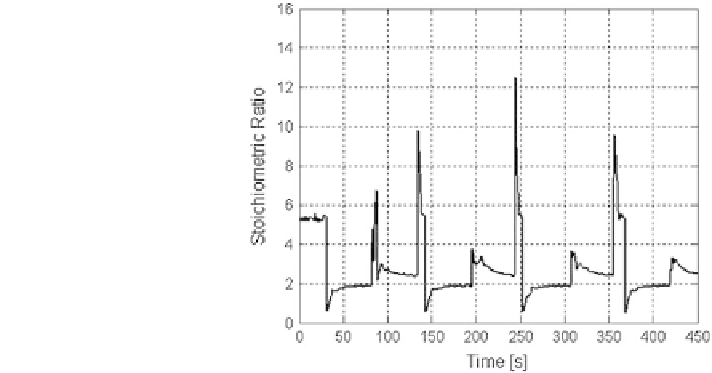Environmental Engineering Reference
In-Depth Information
Fig. 6.26 Acquisition of
stoichiometric ratio versus
time during the experiment of
Fig.
6.22
b (R47 cycle)
generator, the battery power drops to negative values indicating a partial recovery
of energy. During the driving cycle, the battery pack changes its state of charge
(Fig.
6.27
c). The fastest discharge is observed during the first acceleration,
whereas the fastest recharging happens during the first deceleration phase, when
the batteries are recharged by both the electric machine working as generator and
stack.
During the first step at constant speed, a slower SOC decrease is observed,
whereas the last two phases of the cycle (second constant speed step and last
deceleration) define the further battery recharging. The power associated with the
amount of hydrogen entering the stack and power measured at inlet and output of
the DC-DC converter during the cycle are specifically reported in Fig.
6.27
b. The
last two curves evidence the energy loss caused by the DC-DC converter, whereas
the comparison with the hydrogen power plot visualizes the energy loss associated
with the fuel cell system.
The main results obtained by the tests performed in soft hybrid configuration with
the R40 cycle are shown in Fig.
6.28
a-c. During these tests, the contribution of the
batteries to the energy requirement, which comes from the electric drive, is mini-
mized by controlling the DC-DC output power. In Fig.
6.28
a, electric drive, battery,
and DC-DC converter powers versus cycle length are reported. The DC-DC con-
verter dynamic behavior is shown in Fig.
6.28
b, where the DC-DC converter input
and output powers are monitored during the cycle together with the hydrogen power,
in this way indication of the energy losses before the electric drive is given.
The Fig.
6.28
c reports the behavior of batteries during this test by the profile of
battery state of charge versus the cycle length. The dynamic behavior of the fuel
cell system permits the energy requirements from the electric drive to be instan-
taneously satisfied by the stack, with only a small contribution of the batteries.
Therefore, in this test the batteries play the main role of recovering electric energy
during the regenerative braking phases, as evidenced by negative values reached

